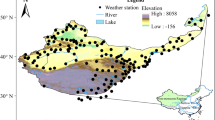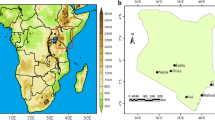Abstract
Interannual variations in the number of winter extreme warm and cold days over eastern China (EC) and their relationship with the Arctic Oscillation (AO) and El Niño-Southern Oscillation (ENSO) were investigated using an updated temperature dataset comprising 542 Chinese stations during the period 1961–2011. Results showed that the number of winter extreme warm (cold) days across EC experienced a significant increase (decrease) around the mid-1980s, which could be attributed to interdecadal variation of the East Asian Winter Monsoon (EAWM).
Probability distribution functions (PDFs) of winter temperature extremes in different phases of the AO and ENSO were estimated based on Generalized Extreme Value Distribution theory. Correlation analysis and the PDF technique consistently demonstrated that interannual variation of winter extreme cold days in the northern part of EC (NEC) is closely linked to the AO, while it is most strongly related to the ENSO in the southern part (SEC). However, the number of winter extreme warm days across EC has little correlation with both AO and ENSO. Furthermore, results indicated that, whether before or after the mid-1980s shift, a significant connection existed between winter extreme cold days in NEC and the AO. However, a significant connection between winter extreme cold days in SEC and the ENSO was only found after the mid-1980s shift. These results highlight the different roles of the AO and ENSO in influencing winter temperature extremes in different parts of EC and in different periods, thus providing important clues for improving short-term climate prediction for winter temperature extremes.
Similar content being viewed by others
References
Chen, L. X., Y. N. Shao, Q. F. Zhang, Z. H. Ren, and G. S. Tian, 1991: Preliminary analysis of climatic change during the last 39 years in China. Quarterly Journal of Applied Meteorology, 2, 164–173. (in Chinese)
Chen, W., 2002: Impacts of El Niño and La Niña on the Cycle of the East Asian winter and summer monsoon. Chinese J. Atmos. Sci., 26, 595–610. (in Chinese)
Chen, W., and L. H. Kang, 2006: Linkage between the Arctic Oscillation and winter cliamte over East Asia on the interannual timescale: Role of quasistationary planetary waves. Chinese J. Atmos. Sci, 30, 863–870. (in Chinese)
Chen, W., H. F. Graf, and R. H. Huang, 2000: The interannual variability of East Asian winter monsoon and its relation to the summer monsoon. Adv. Atmos. Sci., 17, 48–60.
Chen, W., S. Yang, and R. H. Huang, 2005: Relationship between stationary planetary wave activity and the East Asian winter monsoon. J. Geophys. Res., 110, D14110. doi: 10.1029/2004JD005669.
Chen, W., J. Feng, and R. Wu, 2013: Roles of ENSO and PDO in the link of the East Asian winter monsoon to the following summer monsoon. J. Climate, 26, 622–635.
Chen, Y., G. Y. Ren, L. Wang, X. K. Zou, and Q. Zhang, 2009: Temporal change of warm winter event over the last 56 years in China. J. Appl. Meteorol. Sci., 20, 539–545. (in Chinese)
Cheung, H. N., W. Zhou, H. Y. Mok, and M. C. Wu, 2012: Relationship between Ural-Siberian blocking and the East Asian winter monsoon in relation to the Arctic oscillation and the El Niño-Southern Oscillation. J. Climate, 25, 4242–4257, doi: 10.1175/JCLI-D-11-00225.1.
Cheung, H. N., W. Zhou, Y. P. Shao, W. Chen, H. Y. Mok, and M. C. Wu, 2013: Observational climatology and characteristics of wintertime atmospheric blocking over Ural-Siberia. Climate Dyn., doi: 10.1007/s00382-012-1587-6. (in Press).
Coles, S., 2001: An Introduction to Statistical Modeling of Extreme Values, Springer, London, 208pp.
Cressman, G. P., 1959: An operational objective analysis system. Mon. Wea. Rev., 87, 367–374.
Ding, Y. Y., Q. L. Liao, and Y. Wang, 2010: Variations of the winter extreme temperture over Northern China and their relationships with the Arctic Oscillation. Journal of Arid Land Resources and Environment, 24, 95–101. (in Chinese)
Feng, J., L. Wang, W. Chen, S. K. Fong, and K. C. Leong, 2010: Different impacts of two types of Pacific Ocean warming on Southeast Asian rainfall during boreal winter. J. Geophys. Res., 115, D24122, doi: 10.1029/2010JD014761.
Fraedrich, K., J. Jiang, and F. W. Gerstengarbe, P. C. Werner, 1998: Multiscale detection of abrupt climate changes: Application to River Nile flood levels. Int. J. Climatol., 17, 1301–1315.
Gong, D. Y., S. W. Wang, and J. H. Zhu, 2001: East Asian winter monsoon and Arctic oscillation. Geophys. Res. Lett., 28, 2073–2076.
Higgins, R., A. Leetmaa, and V. Kousky, 2002: Relationships between climate variability and winter temperature extremes in the United States. J. Climate., 15, 1555–1572.
Jiang, J. M., and X. T. You, 1996: Where and when did an abrupt climatic change occur in China during the last 43 years? Theor. Appl. Climatol., 55, 33–39.
Kang, L. H., W. Chen, and K. Wei, 2006: The interdecadal variation of winter temperature in China and its relation to the anomalies in atmospheric general circulation. Climatic and Environmental Research, 11, 330–339. (in Chinese)
Li, C. Y., 1990: Interaction between anomalous winter monsoon in East Asia and El Niño events. Adv. Atmos. Sci., 7, 36–46.
Li, Z., and Z. W. Yan, 2009: Homogenized daily mean/maximum/minimum temperature series for China from 1960–2008. Atmos. Oceanic Sci. Lett., 2, 237–243.
Lim, Y. K., and S. D. Schubert, 2011: The impact of ENSO and the Arctic Oscillation on winter temperature extremes in the southeast United States. Geophys. Res. Lett., 38, L15706, doi: 10.1029/2011GL048283.
Liu, Y. X, F. G. Zhou, D. Y. Ping, Z. D. Wen, L. Xin, and Y. Z. Yan, 2010: Variations of winter daily average temperature and extreme temperature in the recently 46 years in China. Journal of ChengDu University of Information Technology, 25, 286–292. (in Chinese)
Liu, Y. Y., and W. Chen, 2012: Variability of the Eurasian teleconnection pattern in the Northern Hemisphere winter and its influences on the climate in China. Chinese J. Atmos. Sci., 36(2), 423–432. (in Chinese)
Song, L. C., 1994: Characteristics of temperature in spatial and temporal variaiton in China during recent 40 years. Quarterly Journal of Applied Meteorology, 5, 119–124. (in Chinese)
Szentimrey, T., 2008: The manual of Multiple Analysis of Series for Homogenization (MASH). Hungarian Meteorological Service, Budapest, Hungary.
Thompson, D.W. J., and J. M. Wallace, 1998: The Arctic oscillation signature in the wintertime geopotential height and temperature fields. Geophys. Res. Lett., 25, 1297–1300.
Thompson, D. W. J., and J. M. Wallace, 2000: Annular modes in the extratropical circulation. Part I:Monthto-month variability. J. Climate., 13, 1000–1016.
Wang, B., R. Wu, and X. Fu, 2000: Pacific-east Asian teleconnection: How does ENSO affect East Asian climate? J. Climate., 13, 1517–1536.
Wang, L., and W. Chen, 2010: Downward Arctic oscillation signal associated with moderate weak stratospheric polar vortex and the cold December 2009. Geophys. Res. Lett., 37, L09707, doi: 10.1029/2010GL042659.
Wang, L., Q. Zhang, Y. Chen, and D. Y. Gong, 2007: Changes of warmer winter and winter temperature over China in the past 50 years. Advances in Climate Change Research, 3, 26–30. (in Chinese)
Wang, L., W. Chen, W. Zhou, and R. Huang, 2009a: Interannual variations of East Asian trough axis at 500 hPa and its association with the East Asian winter monsoon pathway. J. Climate, 22, 600–614.
Wang, L., R. H. Huang, L. Gu, W. Chen, and L. H. Kang, 2009b: Interdecadal variations of the East Asian winter monoon and their association with quasistationary plantary wave activity. J. Climate., 22, 4860–4872, doi: 10.1175/2009JCLI2973.1
Wang, L., W. Chen, W. Zhou, J. C. L. Chan, D. Barriopedro, and R. Huang, 2010: Effect of the climate shift around mid 1970s on the relationship between wintertime Ural blocking circulation and East Asian climate. Int. J. Climatol., 30, 153–158, doi: 10.1002/joc.1876.
Wang, X. D., X. B. Pan, B. J. Long, and C. Q. Li, 2010: Analysis of extreme precipitation and temperature events in Hebei Province over last 50 years. Chinese Journal of Agrometeorology, 31, 170–175.
Wei, K., and W. Chen, 2011: An abrupt increase in the summer high temperature extreme days across China in the mid-1990s. Adv. Atmos. Sci., 28, 1023–1029, doi: 10.1007/s00376-010-0080-6.
Wu, B. Y., and J. Wang, 2002: Possible impacts of winter Arctic oscillation on Siberian high, the East Asian winter monsoon and sea-ice extent, Adv. Atmos. Sci., 19 (2), 297–320.
Xiao, D., and J. P. Li, 2007: Main decadal abrupt changes and decadal modes in global sea surface temperature field. J. Atmos. Sci., 31, 839–854. (in Chinese)
Xue, H., X., D. Meng, D. L. Wu, L. X. Wang, and Q. Li, 2012: Extreme temperature threshold changes and its association with AO index in Ningxia Hui Autonomous Region of China in 1959–2009. Scientia Geographica Sinica, 32, 380–385. (in Chinese)
Yan, Z., W., Z. Y. Li, and X. C. Wang, 1993: An analysis of dedade-to-century-scale climatic jumps in history. J. Atmos. Sci., 17, 663–671. (in Chinese)
Yang, J., C. Ren, and Z. Jiang, 2008: Characteristics of extreme temperature events and its response to regional warming in Northwest China in past 45 years. Chinese Geographical Science, 18, 70–76.
Zhai, P., and X. Pan, 2003a: Change in Extreme Temperature and Precipitation over Northern China during the second Half of the 20th Century. Acta Geographica Sinica, 58, 1–10. (in Chinese)
Zhai, P., and X. Pan, 2003b: Trends in temperature extremes during 1951–1999 in China. Geophys. Res. Lett., 30, 1913, doi: 10.1029/2003GL018004.
Zhang, C., J. B. Zhao, X. Q. Luo, and L. J. Chen, 2011: Correlation between ENSO events and climate impacts in Gansu for 60 years. Journal of Arid Land Resources and Environment, 25, 106–113. (in Chinese)
Zhang, R., A. Sumi, and M. Kimoto, 1996: Impact of El Niño on the East Asian monsoon: A diagnostic study of the 86/87 and 91/92 events. J. Meteor. Soc. Japan, 74, 49–62.
Zhou, W., X. Wang, T. J. Zhou, C. Y. Li, and J. C. L. Chan, 2007: Interdecadal variability of the relationship between the East Asian winter monsoon and ENSO. Meteor. Atmos. Phys., 98, 283–293, doi: 10.1007/s00703-007-0263-6.
Zhou, W., J. C. L. Chan, W. Chen, J. Ling, J. G. Pinto, and Y. Shao, 2009: Synoptic-scale controls of persistent low temperature and icy weather over southern China in January 2008. Mon. Wea. Rev., 137, 3978–3991.
Author information
Authors and Affiliations
Corresponding author
Rights and permissions
About this article
Cite this article
Chen, S., Chen, W. & Wei, K. Recent trends in winter temperature extremes in eastern China and their relationship with the Arctic Oscillation and ENSO. Adv. Atmos. Sci. 30, 1712–1724 (2013). https://doi.org/10.1007/s00376-013-2296-8
Received:
Revised:
Accepted:
Published:
Issue Date:
DOI: https://doi.org/10.1007/s00376-013-2296-8




